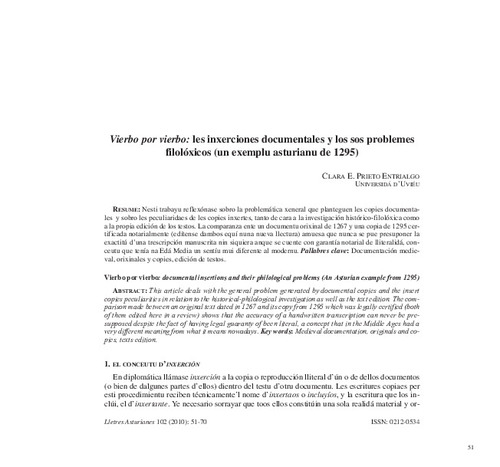Viervo por vierbo: les inxerciones documentales y los sos problemes filolóxicos (un exemplu asturianu de 1295)
Otros títulos:
Vierbo por vierbo: documental insertions and their philological problems (An Asturian example from 1295)
Autor(es) y otros:
Fecha de publicación:
Citación:
Descripción física:
Resumen:
Nesti trabayu reflexónase sobro la problemática xeneral que planteguen les copies documentales y sobro les peculiaridaes de les copies inxertes, tanto de cara a la investigación histórico-filolóxica como a la propia edición de los testos. La comparanza ente un documentu orixinal de 1267 y una copia de 1295 certificada notarialmente (edítense dambos equí nuna nueva llectura) amuesa que nunca se pue presuponer la exactitú d’una trescripción manuscrita nin siquiera anque se cuente con garantía notarial de lliteralidá, conceutu que tenía na Edá Media un sentíu mui diferente al modernu
Nesti trabayu reflexónase sobro la problemática xeneral que planteguen les copies documentales y sobro les peculiaridaes de les copies inxertes, tanto de cara a la investigación histórico-filolóxica como a la propia edición de los testos. La comparanza ente un documentu orixinal de 1267 y una copia de 1295 certificada notarialmente (edítense dambos equí nuna nueva llectura) amuesa que nunca se pue presuponer la exactitú d’una trescripción manuscrita nin siquiera anque se cuente con garantía notarial de lliteralidá, conceutu que tenía na Edá Media un sentíu mui diferente al modernu
This article deals with the general problem generated by documental copies and the insert copies peculiarities in relation to the historical-philological investigation as well as the text edition. The comparison made between an original text dated in 1267 and its copy from 1295 which was legally certified (both of them edited here in a review) shows that the accuracy of a handwritten transcription can never be presupposed despite the fact of having legal guaranty of been literal, a concept that in the Middle Ages had a very different meaning from what it means nowadays
This article deals with the general problem generated by documental copies and the insert copies peculiarities in relation to the historical-philological investigation as well as the text edition. The comparison made between an original text dated in 1267 and its copy from 1295 which was legally certified (both of them edited here in a review) shows that the accuracy of a handwritten transcription can never be presupposed despite the fact of having legal guaranty of been literal, a concept that in the Middle Ages had a very different meaning from what it means nowadays
ISSN:
Identificador local:
20101024
Colecciones
- Artículos [37540]
- Filología Española [536]
Ficheros en el ítem





